
|
Saving Communities
|
||||||
Home |
Site Map |
Index
|
New Pages |
Contacts |
The Private-Investment Community Land Trust
A Better Way to Revitalize Communities
by Dan Sullivan
The essential concept
The private-investment community land trust is an alternative
system for private land-holding, for generating community revenues, and
for encouraging better land use. Essentially, land users lease the
land, rather than purchase it, from a land trust. The trust then uses
lease revenues to pay investors, to provide community services, to
rebate taxes levied against occupants of trust land by larger taxing
bodies, and to acquire additional land. It has many advantages over our
traditional land tenure system, and particularly over urban-renewal
projects, to the occupants, the investors, and the communities in which
they are located.
 Current Occupants Can
Stay
Current Occupants Can
Stay
People often complain that urban redevelopment projects create
"gentrification," by which they mean pushing poorer people out in order
to entice richer people to move in. The land trust approach attracts
richer people and more dynamic businesses with little or no
displacement of those already living or doing business in the
community. Studies show that when a community gradually improves, it
actually loses fewer
residents than similar communities that stagnate
or continue to decline. The real cause of displacement is the urban
renewal project that is undertaken to trigger gentrification. Indeed,
the original term for "urban renewal" was
"slum clearance." The painting at left was of Ruch's Hill in
Pittsburgh's Hill District. No economic development followed, and the
land was eventually used for the Elmore Square housing projects, which
have also been torn down. Ironically, Elmore Square was to house people
displaced by other Urban Renewal projects.
The land trust model does not push
people out. To the contrary, it
invites landholders to sell their land to the trust and rent become
trust members on
the same terms that attract others to the neighborhood. They
also have the option of keeping their conventional land titles and
enjoying trust leaseholders as neighbors.
No Risky, Expensive Projects

The
track record of conventional urban renewal projects is
spotty, at best. Billions of dollars of public money have been spent on
failed projects. In Pittsburgh, the only major multi-building,
multi-owner projects that
could be called clear financial successes over the long term are Gateway
Center and Station
Square.
Parkway
Center Mall
(pictured at right) was successful for about two decades, but had been
built on a landfill and failed both structurally and economically. The
project
wasted a fortune in public money, not only on the mall itself, but on
an
interstate exit specially built to service the mall.
Allegheny
Center Mall
was an economic disaster almost immediately. The retail shops that were
supposed to serve surrounding residential developments quickly closed
and the spaces were eventually used as offices.
Penn
Circle,
which was supposed to revitalize East Liberty, saw one project disaster
after another, and quite literally became a textbook example of how not
to revitalize a community. It is only now beginning to succeed after
half a
century of failure.
Perhaps the biggest disaster, both
economically and socially, was the
clearance of the Lower Hill District beginning in the late 1950s that
forced thousands of people into housing projects and left much of the
land in limbo until the mid 1990s. The main project,
the Civic Arena, was torn down owing more money than what had been owed
when that hockey arena first opened. Three Rivers Stadium on the North
Side also had a much larger outstanding debt when it was torn down than
when it had first opened.
The land trust approach does not involve
projects. It simply creates
incentives that encourage ordinary people to take up land in the trust
and put it to better use.
 No
Economic Cannibalism
No
Economic Cannibalism
Even the most successful renewal
projects destroy other
Pittsburgh businesses. They create new businesses that steal customers
from existing businesses, often without doing anything to increase the
overall market for these businesses. When the Grand Concourse opened at
Station
Square, it was ballyhooed by the Urban Redevelopment Authority, elected
officials and newspapers as the
place for seafood. As a result,
nationally famous Klein's
Seafood quietly went out of business. It had been such a Pittsburgh
landmark that its sign now hangs in the Heinz History Museum.
Businesses already pay higher tax rates in
the City of Pittsburgh than
in the suburbs. Part of their taxes go to subsidizing
their own competitors.
When the tax-subsidized East Liberty Home Depot opened in 2000, there
were eleven hardware stores within a 2.5 mile radius. By 2010, there
were none. Carpet stores, paint stores, plumbing and electrical
suppliers and other competitors also closed or moved out of the city.
The owners of these stores were driven out of business by the same city
to which they had taxes that were used against them.
Worse still, after Giant Eagle Supermarkets
got subsidies to build
large stores with parking in prime neighborhoods, they closed smaller
neighborhood stores in poorer neighborhoods. People do not buy more
groceries because we subsidize new grocers. Instead, we subsidized the
closing of small grocers and even of neighborhood Giant Eagles. This is
economic cannibalism - subsidizing new businesses to eat up the profits
of
existing businesses.
The land trust does not take money from some
businesses to
subsidize others. All tax advantages to businesses in the trust are
funded from land rents paid to the trust. Established businesses who
want these advantages can also sell their land to the trust and
enjoy the same incentives as other trust lessees.
No Eminent Domain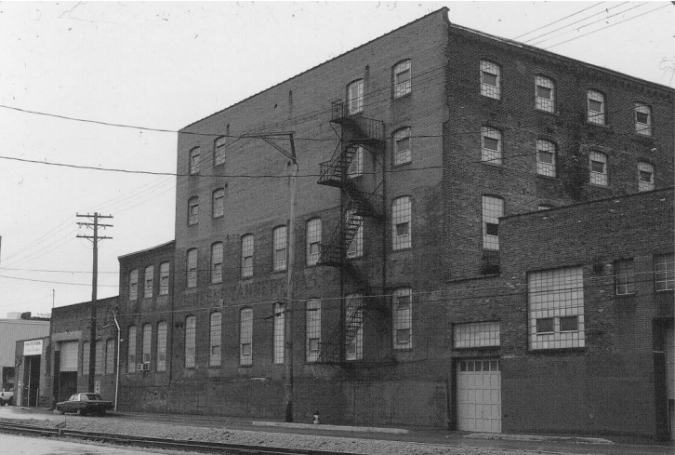
It is almost impossible to assemble
land for large-scale
development projects without resorting to eminent domain. Even Gateway
Center used eminent domain against more than 100 property owners. The
pattern is that small property owners who do not fight the takings in
court are poorly compensated, while those who conduct high-profile
campaigns are often given many times what the properties are worth.
Pittsburgh Wool won such a fight and was awarded $7.5 million for the
factory pictured at right, that had an estimated value of only $1.5
million. The settlement was heralded as a victory for property owners
everywhere, but other taxpayers had to cover a $6 million overcharge.
Although the land trust has more synergy if
it owns all the properties
in an area, it is not so important as to require the use of eminent
domain. Small property owners can join the trust or not, as they see
fit.
No Corporate Welfare
Development projects usually
involve massive subsidies to large corporate interests - from
construction firms to commercial occupants. Much of this is
unavoidable. Small independent business owners are usually too busy
tending to their own operations to even pay attention to
development-project opportunities. Large corporations, on the other
hand, have agents who specialize in negotiating deals with development
agencies.
The land trust approach involves no
subsidies. All tax advantages come
from rent revenues. People are encouraged to take individual properties
and put them to good use, which means ordinary businesses and residents
are on equal footing with large corporations.
No Insider Deals
Developers
like to keep their projects secret from those who
might buy land out from under them, from competing developers,
and even from community members who might organize against the project.
this secrecy compounds problems when public money is involved. Even
politicians who give lip-service to openness and transparency find that
the very nature of development projects prevents them putting together
deals in a transparent fashion. Local community organizations, who had
been promised that they would be part of the project planning process,
often find project plans handed to them as a fait accompli. The most
progressive developers will listen to community leaders, but will not
reveal tentative plans and negotiate along the way. This is not the
fault of particular developers or particular politicians, but is in the
very nature of large-scale developments.
The land trust, on the other hand, is open
from beginning to end. The
land trust proposal, the charter, the process for selling shares, the
lease agreements, the internal governance of the trust and all other
issues are completely open.
Idle Land Speculation Ended
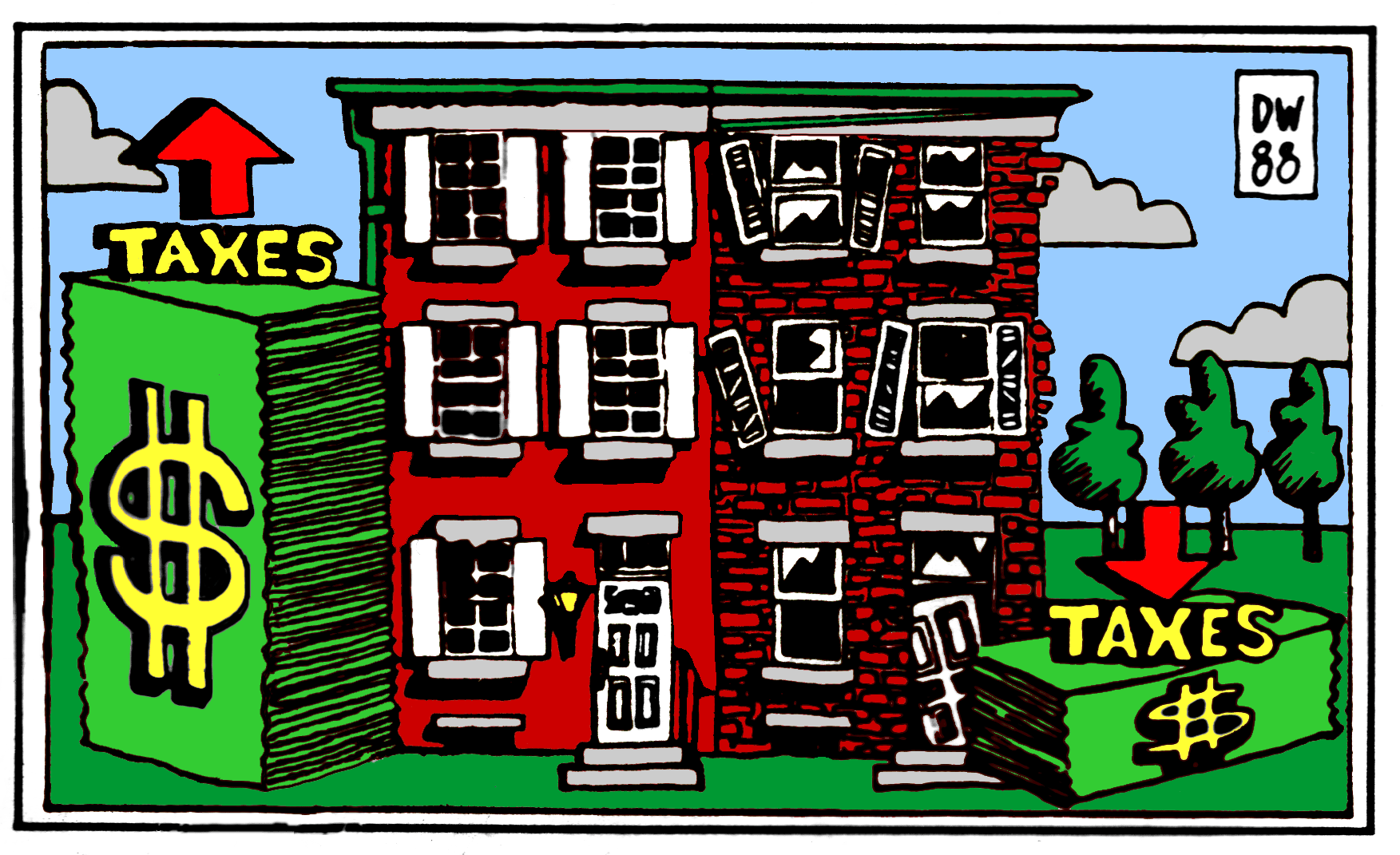 Our
current tax system punishes good behavior with high taxes and rewards
idle speculation with low taxes. Wage taxes, sales taxes, income taxes,
business taxes and the building portion of the property tax all fall on
those who putting their land to good use and making the community more
dynamic. Each land speculator minimizes his taxes an maximizes
his profits by getting others to improve and operate their properties
while he sits back and watches the value go up. That is, he becomes an
enemy of the very revitalization he from which hopes to profit. If too
many speculators do this, the community deteriorates and everyone's
land loses value. That is, the idle speculator is even the enemy of
other idle speculators. Still, the last one to develop gains the most.
Urban renewal projects actually
Our
current tax system punishes good behavior with high taxes and rewards
idle speculation with low taxes. Wage taxes, sales taxes, income taxes,
business taxes and the building portion of the property tax all fall on
those who putting their land to good use and making the community more
dynamic. Each land speculator minimizes his taxes an maximizes
his profits by getting others to improve and operate their properties
while he sits back and watches the value go up. That is, he becomes an
enemy of the very revitalization he from which hopes to profit. If too
many speculators do this, the community deteriorates and everyone's
land loses value. That is, the idle speculator is even the enemy of
other idle speculators. Still, the last one to develop gains the most.
Urban renewal projects actually 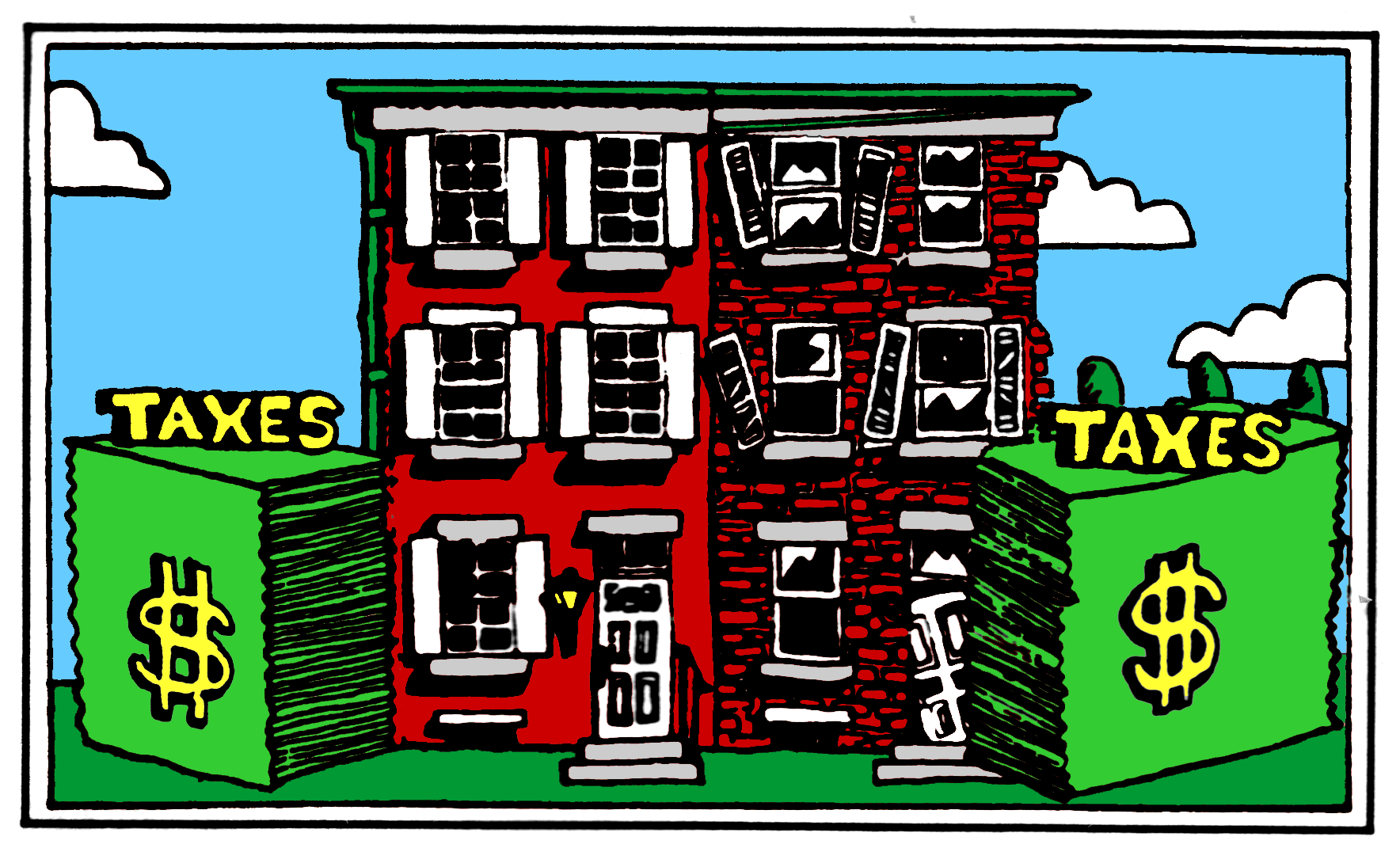 encourage idle speculators to hold on in hope that the
redevelopment authority will bail them out.
encourage idle speculators to hold on in hope that the
redevelopment authority will bail them out.
The land trust reduces this. Every
leaseholder pays a fair
rent on the value of his land, and a large portion of the lease revenue
is used to rebate taxes on his improvements and on desirable
activities. Although one can speculate on shares of land trust itself,
the shareholders have no control over land use. Their only powers are
to demand that the terms of the trust be upheld and to bring additional
land into the trust.
All control of land-use decisions rests
with the Leaseholders
Association, the Occupants Association, and individual leaseholders.
The trust is designed so it is in everyone's interest to make the
community as dynamic as possible.
Healing communties, not replacing them.
Urban redevelopment projects are
like tissue transplants. They
cut out rotted parts of a community, along with the people who live in
them, and replace the rotted parts with entirely new properties. One of
the reasons these "property grafts" fail so often is that they do not
deal with the underlying problems, or with the bad incentive structure
that caused the communities to decline in the first place.
The land trust changes those incentives so the
trust community can heal
naturally. As with any healing, improvement is first seen at the edges
and the blighted area shrinks away.
Localized and Specialized Control
The trust divides power into three sets of
associations.
The
Shareholders Association represents those who have put up the
money to
make the trust possible, the Leasholders Association represents people
who have taken up leases, and the Occupants Association represents the
people who actually live and work on trust land. The Leaseholders and
Occupants Associations are further divided by neighborhood and by
residential occupancy and employee occupancy. (On-site business owners
and managers are included in the employee occupancy criteria.)
Amending the trust charter or changing
future leases requires that all
three associations concur. Other decisions may be made by one or two
associations alone.
The Shareholders Assocation and each
member thereof has standing to
demand that the trust be administered as prescribed in the charter.
This is very important, as similar trusts have violated their charters
by collecting as little rent as possible. Because nobody had standing
to demand that the charter be administered as prescribed, these trusts
failed to offer the promised rebates or to acquire new land, even when
excellent opportunities presented themselves. The Shareholders
Association also controls the fund for additional land purchases, and
can make such purchases on behalf of the trust.
Each community's Leaseholders Association and
Occupants Association
have joint jurisdiction over how their portion of the rent fund in
their community is allocated between capital improvements, operations
and tax-rebate incentives, except that the trust-wide associations
might
set minimum-rebate policies in order to advertise those policies, and
the Shareholders association might grant additional funds to particular
neighborhoods.
Until there are enough leaseholders and
occupants, representatives of
community groups and Community Development Corporations can perform
these functions. This puts initial control at the neighborhood level.
Customizable Incentives Promote
Local Priorities
The land trust does not rely on planning
and projects, but on
built-in, rent-funded incentives that attract the kinds of development
that the local communities want. Community groups and Community
Development Corporations can set up the incentives. Once the land is
leased, the lessees and occupants control the incentives and other
trust aspects themselves.
Where
the local trust village chooses to rebate taxes on employers and
employees, the best deal goes to the leaseholder with
the biggest payroll for the land he occupies. That means not only the
most employees, but the best-paid employees. Rebating mercantile and
sales taxes attracts the store owners who expect to have the highest
sales volumes. If
the community wants to attract the working poor, it can rebate a
portion of wage taxes on residents up to a particular income level,
such as rebating taxes on the first $20,000 of earned income tax. In
Pittsburgh, it might want to rebate the most regressive tax of all, the
$52 per capita tax on every employee at the job site.
If the trust wants to attract families
with children, it can
offer child care vouchers and education vouchers. These vouchers can be
cumulative so those who attend public schools can save them for
vocational schools or higher education. For every desired outcome,
there can be an
incentive system that promotes an outcome without resorting to hard
and vast rules that mandate that outcome.
Flexible land use
Even
the best-planned communities have run into problems as conditions
changed.
For example, Columbia, Maryland has been heralded as a quintessential
example of a well planned community. Yet as times changed, they found
that they had relied too much on physical planning and hadn't addressed
underlying economic dynamics. Serpentine roads that were all the
rage when the towns were planned in the 1960s have become problematic
as reliance on mass transit has become more important. Embedding houses
in
wooded lots, which was appropriate to the surrounding areas at the
time, has left Columbia more vulnerable to criminals from poorer
neighborhoods that have grown up around Columbia. Most of all,
these planned communities have not avoided the bad economic incentives
that have lead to blight generally. For example, The West Lake Village
Center, one of Columbia's planned shopping districts, (shown at right)
is now dependent on urban renewal projects for rehabilitation.
By using economic incentives instead of
relying on hard planning alone,
the trust avoids the pitfalls of planned communities. The incentives
lead naturally to good urban land use, reducing the need for even
conventional zoning.
Small Businesses Attracted
Small businesses employ more people on less land than big businesses. Rebates to wage taxes, or to employers' contributions to payroll taxes, are a better deal for small businesses than for big businesses. New small businesses are also more concerned about startup costs, and are happy to lease land rather than purchase land. In the same way, small home builders and struggling home buyers are drawn to the trust because it avoids land acquisition costs. It has the opposite effect of of redevelopment projects, which push out small struggling businesses to attract corporate chain stores.
The Rent Funds
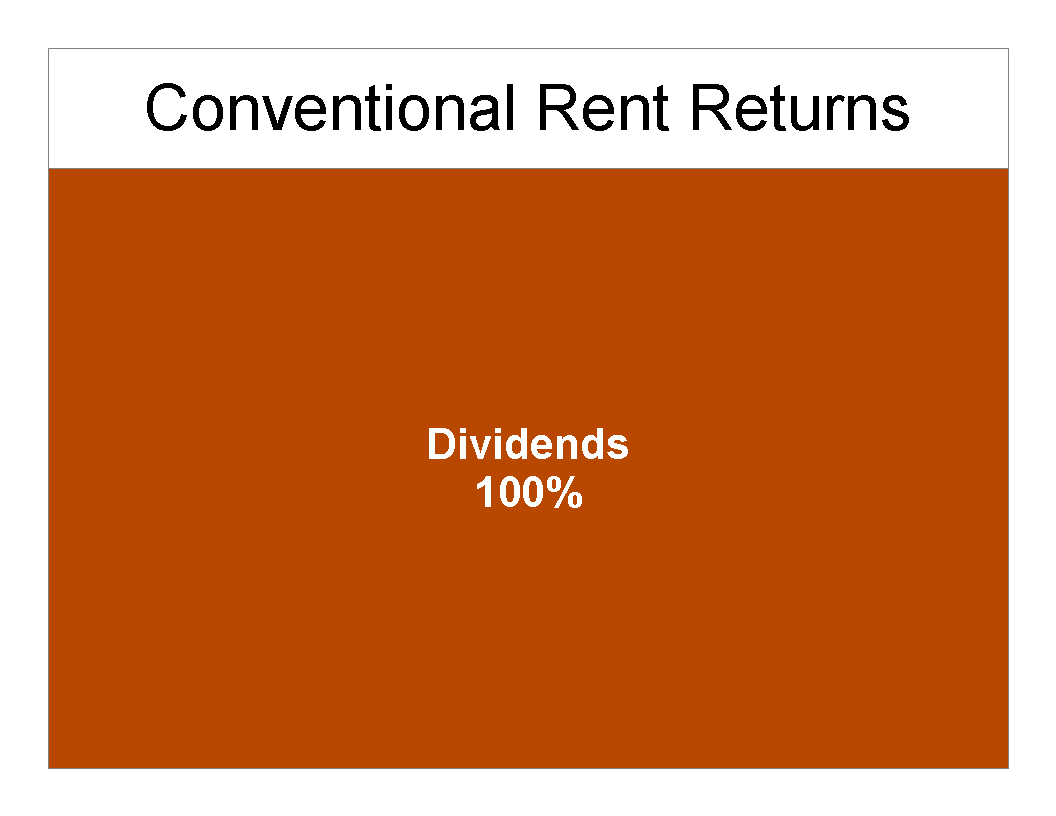 Many commercial properties are built
on leased land.
Usually,
the leaseholder is entirely responsible for all taxes, for attracting
tenants, for providing amenities, and so on. The landlord pockets the
entire rent as a profit or dividend. This works well enough for
prime land, where there is no difficulty attracting tenants.
Many commercial properties are built
on leased land.
Usually,
the leaseholder is entirely responsible for all taxes, for attracting
tenants, for providing amenities, and so on. The landlord pockets the
entire rent as a profit or dividend. This works well enough for
prime land, where there is no difficulty attracting tenants.
However, the land trust model is
designed to create a synergistic
effect by attracting better tenants to poor neighborhoods where those
tenants would not commit to a conventional lease.
First of all, the land trust continues to pay
all taxes on the land
itself. Should the city or borough increase real estate tax rates, the
trust bears the entire increase on the value of land.
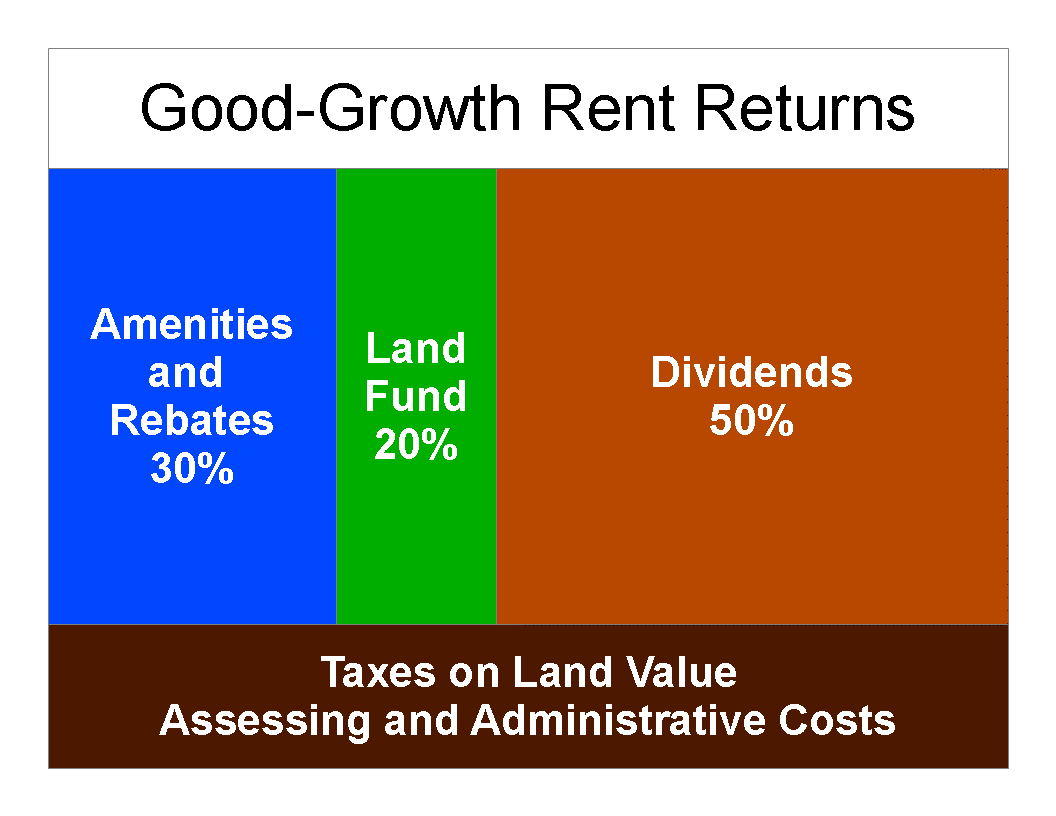 Second,
the trust sets aside a significant portion of the rent to rebate taxes
that fall on the leaseholder or his occupants. This is not merely a
rent discount, but an incentive to get the leaseholder and his
occupants to more fully use the land.
Second,
the trust sets aside a significant portion of the rent to rebate taxes
that fall on the leaseholder or his occupants. This is not merely a
rent discount, but an incentive to get the leaseholder and his
occupants to more fully use the land.
Third, the commitment to continually buy more
land and bring it into
the trust protects those who build today from being pushed out by those
who would build even more tomorrow and would bid up the rent to do so.
(Additional rent protections follow.)
This can only work for shareholders if the
result is not a zero-sum
game. That is, the stockholders hope to come out ahead with a smaller
share of a much larger pie. If it works well for occupants and
leaseholders, and if they make the most of the incentives by doing more
with less land, it will also work well for the shareholders.
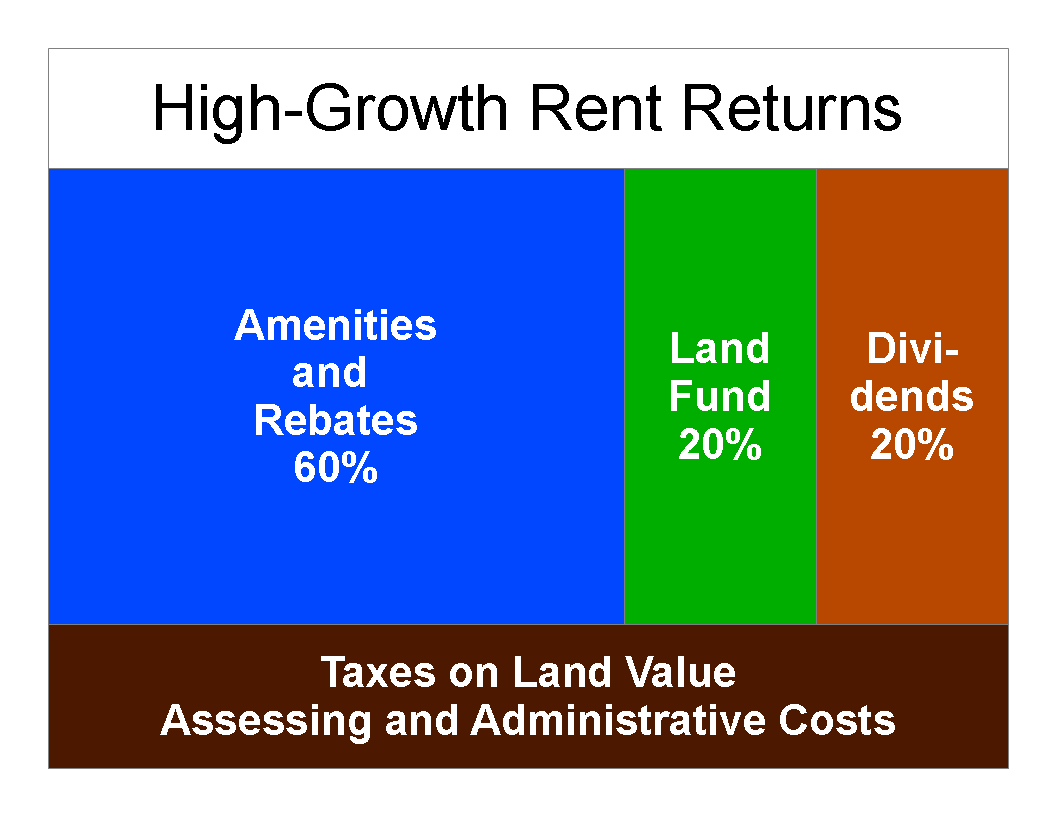 In
ordinary circumstances, dedicating 30% of the rent to rebating taxes
should be enough to attract
people to the trust. In blighted areas, larger rebates would
probably be necessary to get things started.
In
ordinary circumstances, dedicating 30% of the rent to rebating taxes
should be enough to attract
people to the trust. In blighted areas, larger rebates would
probably be necessary to get things started.
The trust could specify a high-growth
incentive system for a specified
period of years, or until a specified goal is attained, and shift to a
good-growth system after that. However, such a change would have to be
written into the original charter. Once the charter is in place the
shareholders cannot unilaterally decrease the rent share that goes to
amenities and rebates.
A taxing jurisdiction might also give the
trust a better deal on vacant
properties held by that jurisdiction, contingent on the shareholders
taking smaller dividends and increasing the fund for amenities and
rebates. That way the taxing jurisdiction gets the development it
desires more quickly, and also gets most or all of the rebate revenue.
However, there is a point at which the trust ceases to be an
investment, and the shareholders are essentially purchasing stock for
charitable reasons. It is wise to set the divisions to maximize growth,
but also to guarantee adequate initial investments.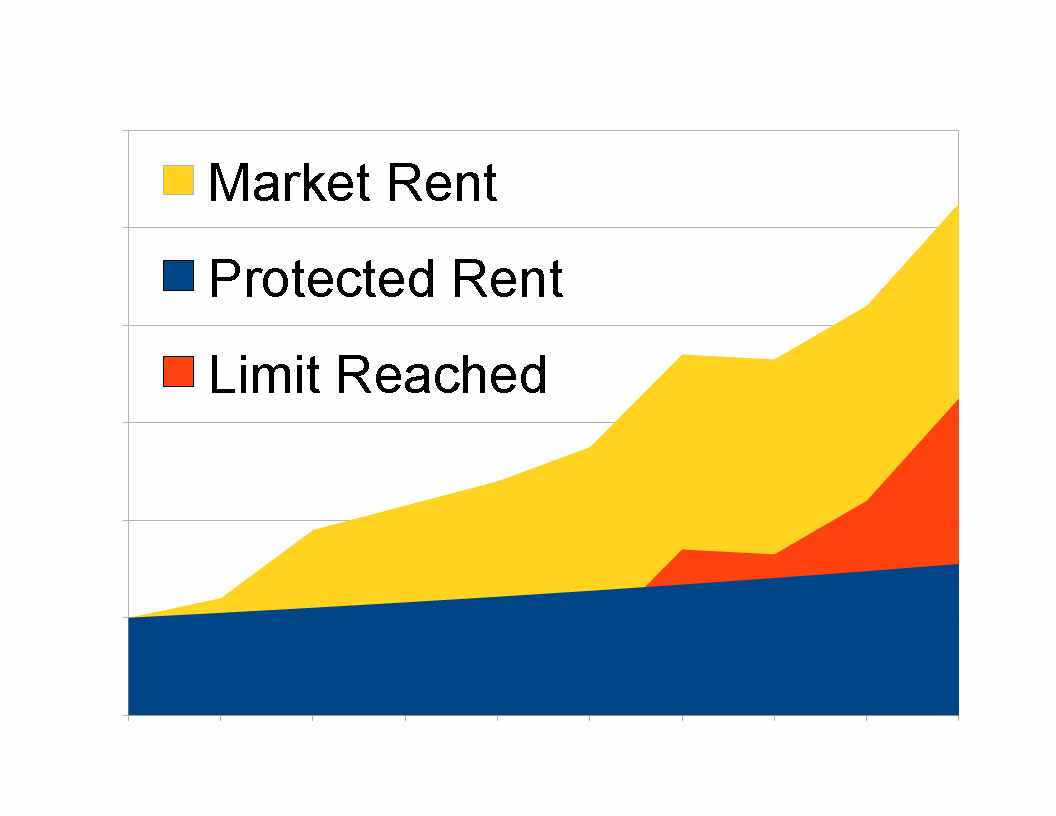
Rent Increase Protections
The trust
reassesses the rent annually using market data,
including bidding on any vacant lots. The lessees can be protected from
large increases, but only up to the rental value of their buildings.
For
example, say that the protected rent is a limited to a fixed increase
plus general inflation. But as the
land trust is likely to be very successful, land might go up by far
more than that. In the graph at right, the yellow area is the market
rent, the blue area is the protected rent, and the orange area shows
what happens when improvements do not warrant complete protection.
A vacant lot gets no protection unless it is
joined to an improved lot.
If the leaseholder makes significant improvements are in the future,
the rent returns to what is shown on the blue line.
An improved lot, or set of lots, is
protected as long as the value of
the improvements is greater than the value of the protection. Suppose,
for example, that the leaseholder parks a mobile home on one of the
lots. As long as the rental value of the mobile home exceeds the
difference between the protected rent and the market rent, he gets the
full protection. However, if rent protection exceeds the value of the
mobile home, he begins to pay higher rents (orange area). To remedy
this, he can build a more valuable structure, or even (zoning
permitting) put a second mobile home on the lot. Because the rent
would continue to climb, we recommend a that people erect high-value
permanent structures that take full advantage of the rebate incentives.
However, mobile homes and other temporary structures are good interim
uses of the land while people learn what is likely to become the best
long-term use of the land.
Better Internal Political Systems
The concept of a democratic republic
is that the people
deliberate and choose their leaders. However, modern democracy, which
is based on elections and majority rule, has become dominated more by
power struggles and propaganda bombardments than by deliberation.
The ancient Greeks didn't have elections.
Local decisions were made by
whoever showed up to vote on those decisions, and Senates of Greek
city-states were chosen by lottery. While this approach eliminated the
power struggles of political campaigns, they had other problems.
The meddlesome tended to show up most often to town councils, and
the Senates were made up of people who often just average or even below
average in their ability to govern.
A third form of democracy, somewhat similar to
the way Greeks choose
their Senators, is the jury system. We trust juries to decide who goes
to prison and who goes free, and sometimes who lives and who dies.
Ideally, juries are also chosen by lottery, although this has been
modified to eliminate jurors who have conflicts of interest.
We propose juries, not to run trust
operations directly, but to chose
the most talented, most dedicated, and most ethical leaders, to
oversee those leaders, and to propose and adopt changes to governing
documents. Juries select representatives for routine decision-making,
and
are only called to deliberate on policy measures. Juries are far more
resistant to special-interest
campaigning, and the meddlesome have no greater chance to serve on
juries than anyone else. Of course, those who are concerned or
knowledgeable can testify to the juries.
Jury service would be entirely voluntary, and
jurors should be paid
enough that at least 50% of those invited volunteer to serve.
Small Investors Favored
In an normal corporation, board
members are elected on the
basis of
one share, one vote. A single shareholder or a small number of
shareholders who have over 50% of the shares have absolute power over
the corporation. In contrast, the land trust uses a jury system to
select board members. The trust invites shareholders to serve on
Shareholders Association juries
by lottery. While each shareholder's chances of serving on such a jury
is proportionate to his number of shares, even the largest shareholder
can only have one seat on a jury. This creates a balance between large
and small shareholders that prevents large shareholders from dominating
the trust.
Also, while institutions (particularly
non-profits) are welcome to buy
shares, only real persons who own shares in their own names are invited
to
serve on shareholder juries.
Small Leaseholders Also Favored
Each leaseholder's chances of being invited on to a jury is also proportion to the rent paid for his leasehold or leaseholds. Family owned corporations may designate a family member to be eligible for jury service, but extended and publicly traded corporations are not represented.
Occupant Juries and representatives
Matters that affect
all occupants are composed of both residential and employment-based
occupants. Matters that pertain to residential or employment-based
occupants alone can be decided by their representatives alone.
Innovated from Successful Precedents
Endorsements from economists
The trust incentive system has been proven, both by taxing
jurisdictions that taxed land values instead of buildings, wages,
business activities, etc., and by actual trusts, a number of which were
formed at the turn of the last century. The essential concept dates all
the way back to John Locke, who noted that all taxes come out of land
rent anyhow, and that other taxes are so destructive that it is better,
even for the landowners, to pay the taxes directly than to try to make
their tenants pay:
It is in vain, in a country whose great fund is land, to hope to lay the publick charge of the government on any thing else; there at last it will terminate. The merchant (do what you can) will not bear it, the labourer cannot, and therefore the landholder must; and whether he were best to do it, by laying it directly where it will at last settle, or by letting it come to him by the sinking of his rents, which when they are once fallen, every one knows are not easily raised again, let him consider.
- John Locke "Some Considerations of the Consequences of the Lowering of Interest, and Raising the Value of Money."
Other
economists and economic philosophers have also endorsed raising public
revenue from land values throughout history, from classical liberals
like the French Physiocrats, Adam Smith, William Penn, Herbert Spencer,
Ben Franklin, John Stuart Mill, Thomas Jefferson and Tom Paine, to
modern economists including Nobel Laureates James Buchanan, Milton
Friedman, Franco Modigliani, Paul A. Samuelson, Herbert
A. Simon, Robert M. Solow, Joseph Stiglitz, James Tobin and William
Vickrey.
We have also seen the benefits of charging for land in hundreds of
taxing jurisdictions around the world, including many jurisdictions in
Pennsylvania.
Jurisdictions using land value tax
HOW THE PRIVATE INVESTMENT LAND TRUST OPERATES
The private investment land trust is created out of
a contractual agreement between an investors1 corporation, a
leaseholders1 association, and a non-profit community corporation. The
land is owned by the investors' corporation, but the deeds are held in
escrow to guarantee the security of the leaseholders and other
community residents.
An independent real estate appraiser determines the
fair market rent of each land parcel based on real estate statistics.
If the investors' corporation and the leaseholders1 association are
both satisfied with the quality of county tax assessments, they can be
used for determining rents.
Every four years, parcels are re-appraised, with
particular attention given to separating the value individual
improvements made by the leaseholders and residents from the value of
the parcels themselves.
Lease rents are determined by the unimproved values
of the parcels using a predetermined formula. Between appraisals, lease
rents are adjusted according to a general inflation index or by a land
price index for the area.
Leases are administered by an independent real
estate agent, or, if agreed upon, by a member of the community.
The rents are collected, and the costs of
administering the leases are deducted. Also, all property taxes
accruing to land values are deducted.
The remaining proceeds are divided according to an
established formula. A portion goes to the community corporation, a
portion to the investors1 corporation, and a portion into a fund for
future land purchases.
The funds allocated to the community corporation are
used first to pay property taxes on improvements owned by the community
and by community members. Additional revenues can be used to finance
community improvements and services. Any funds still remaining are used
to pay other taxes incurred by the tenants.
The portion sent to the investors' corporation is
distributed as dividends to the investors after necessary corporate
expenses have been paid.
The portion allocated for future land purchases is
put in a fund held jointly by the community corporation and the
investors' corporation. When both groups agree, the fund can be used to
purchase land adjacent to the community, which then becomes a part of
the community.
If the fund reaches an established limit and no
adjacent land purchases are agreed upon, the investors' corporation can
use the funds to purchase another tract of land elsewhere, where
another leaseholding community will be established.
Land for expansion can be acquired in other ways as
well. Additional investors can be invited to join the corporation and
be issued stock commensurate with the value of their investment. They
can invest with money, which is placed into the expansion fund, or with
suitable land, which becomes a part of the community upon being
invested in the corporation. Occupants of the land are offered priority
in taking leases.
ADVANTAGES TO THE LEASEHOLDER
There are several advantages which accrue to the
leaseholder. First of all, he does not have to make an initial purchase
to acquire land. His funds can be directed toward making property
improvements. He does have to pay a fair market rent, but this costs
far less than a mortgage on the land would cost.
Mortgage costs include interest plus "amortization"
of the purchase costs; land rent reflects interest value alone. Also,
the purchase price of land is artificially high due to the presence of
land speculators who bid up prices. However, leases of this type are
not attractive to speculators. Land rent, therefore, does not reflect
"speculative" value.
Although land rents will continue and gradually
increase, while mortgage payments end after thirty or forty years, the
most difficult financial period for most homeowners is while their
house is still being paid for. Being able to defer land payments by
leasing helps them get through this critical period. A leaseholder who
wants to make higher payments and have equity in his share of land in
the community can become an investor as well by purchasing stock in the
landholding corporation.
The leaseholder is just as secure in his lease as he
would be holding a deed. The leases are fully transferable, and the
rents are guaranteed not to exceed fair market value.
Conventional landowners can lose their property for
failure to pay any number of taxes imposed upon them -- taxes which can
be selective, arbitrary, and unfair. Some leases shield leaseholders
from discriminatory taxation, and are, therefore, better security than
a conventional deed. Under a tax-sheltering land lease system,
leaseholders can build homes, earn wages, etc., without being taxed for
these activities by local governments.
Also, leases are not subject to the deed transfer
tax, which, in Pennsylvania, takes two percent of the purchase price
from conventional property owners every time title is transferred.
Leaseholders can sell their property improvements and transfer their
leases without anyone having to pay transfer taxes.
The community corporation can and should co-endorse
home improvement and construction loans, since some banks are reluctant
to issue mortgages on leased property. However, more credit is
available to community-backed leaseholders than to conventional
landowners. The community corporation can even start a credit union for
improvement loans with revenues in the expansion fund. Such a policy
greatly increases the opportunity for leaseholders to acquire funds for
property improvements.
The leaseholder's biggest advantage is the assurance
that adjacent properties in the community will not become derelict.
Because land rent is collected by the community corporation, it is not
profitable to hold leased land out of use. Negligent absentee
landlordism is virtually non-existent in land-lease communities.
ADVANTAGES TO THE COMMUNITY
Advantages which accrue to responsible, energetic
leaseholders translate into advantages to the community and to all of
its members.
When the lease system and other considerations are
designed to create a particular set of advantages, the community
attracts people interested in those advantages. People who like a
particular kind of community will like a particular kind of lease, for
the lease provisions embody the essence of the community structure.
A lease system that gives advantages to
conscientious homeowners is not particularly attractive to exploitative
landlords or to demoralized and unambitious squatters. Even if such
people find their way into a leasehold community, it is likely that
they will either become productive community members or that they will
leave.
Because the land is not owned as separate parcels,
the community is not torn by conflicts of interest that arise between
private landowners. And because the land is leased, and property
improvements privately owned, the community does not have to depend on
rigid structures and strong leadership, which are often necessary in
communities where common ownership goes beyond ownership of land.
The land lease community does not have to resort to
taxation to pay for community improvements. This guarantee against
taxation makes the leases more attractive. Moreover, using land rents
for financing community improvements provides sound criteria for
judging whether an improvement is worthwhile: a worthwhile improvement
makes the community a more desirable place in which to live; a more
desirable community commands higher land values and, therefore, higher
rents. The increase in rents to the community fund automatically pays
for most economically sound community improvements. In fact,
leaseholders who benefit most from a community improvement pay the most
for it, as their benefits from the community are part of the basis of
their assessed rental obligations.
Because the community is run as a private
corporation and not as a municipality, it has greater flexibility than
local governments. It can be run by town meetings, elect officials
within the structure of its choice, and even choose leaders by lottery.
It can operate like a private condominium development, or it can take
on what are considered to be municipal functions. If revenues permit,
it can even provide for private education without interference from the
state.
The Fairhope Single Tax Colony, for example, created
the still thriving community of Fairhope, Alabama in 1894. Fairhope is
like any other municipality except that it has no taxes; all municipal
services being paid for out of lease revenues. Because all the property
in Fairhope is listed on a single deed, the corporation was able to
have all public utilities delivered directly to the corporation at
reduced rates available only to large users. The corporation is able,
therefore, to provide utility services to community residents at a
savings.
The amount of services a land-lease community can
provide for its members depends on how much revenue it collects, and on
what portion of that revenue is allocated for community services. But
the absence of idle speculation creates advantages in all land-lease
communities, even if they defray no taxes for the leaseholders and
allocate no revenues for community services.
ADVANTAGES TO INVESTORS
Investors in the community corporation are
essentially landowners who have pooled their resources and have given
up control over land use to the community and to the leaseholders.
Because they have invested their money, they are
entitled to dividends. As with any growth investment, dividends are
lower at first, but increase with the growth and development of the
community. If the lease agreements allocate a large portion of lease
revenues to the community fund and expansion fund, initial dividends
are even lower, but the growth of the community is faster, yielding
higher dividends in the future.
By owning shares in a community instead of parcels
within the community, investors know they will not be indifferent to
one another's desire for a return on investments. Stockholders in a
community have a natural harmony of interests, compared to the often
conflicting interests of investors in land parcels.
Private land speculators have a natural tendency to
want to see their neighbor's land developed first. By the same token,
anyone investing in land next to a speculator's land will find his
speculating neighbor to be a drag on community development. In a lease
community there is no such drag. Investors in such a community can be
confident that the community will grow smoothly and evenly.
In communities that shelter residents from property
tax and other taxes, community members are even more eager to improve
their properties, making the community grow even faster. In the long
run, this means higher returns to investors.
Investors can also transfer their holdings without
having to pay transfer taxes and without disrupting the lives of the
leaseholders.
Investing in a private community land trust is every
bit as sound as investing in land directly. In the long run it will pay
more; it is easier and more convenient to sell shares in the trust than
to sell real estate directly; and it is certainly more ethical and
prestigious to invest in a community land trust than to be a land
speculator.
The fact that the land trust is such a good deal for
leaseholders and residents makes it a better deal for long term
investment as well. Leases are accepted quickly, people tend to develop
their properties more fully, and as the community develops a reputation
for being a fine place in which to live, rental values automatically
increase.
OTHER ADVANTAGES
There is a growing number of people who believe in
the land trust concept as crucial to the vitality of social
development. If invited, many of these people would eagerly invest in a
land trust community like the one outlined above. Some people have even
expressed an interest in bequeathing portions of their estates for the
promotion of land trusts. Indeed, many land trust communities have been
at least partially funded by bequests of this kind.
Investment in the land trust does not have to be for
private gain. Investments can be made naming charities as
beneficiaries, and investments can be made by the charities themselves.
The community fund itself can be the beneficiary of investment
dividends, or dividends can be placed in the expansion fund.
The unique and progressive features of a
private-investment land trust community make it a suitable subject for
many alternative publications, and generate opportunities for free
publicity. Such publicity attracts potential investors as well as
potential leaseholders.
STARTING A LAND TRUST CORPORATION
Starting a land trust corporation requires careful
planning and sound legal judgment. Fortunately there are a number of
organizations interested in land trusts which can be helpful with
problems of designing leases, developing community structures, etc.
Also, there are existing land trust communities which can serve as
models for future communities.
Most land trusts are non-profit and have no
provision for expansion, and some are radically different from what is
outlined above. Still, information about these trusts can be helpful to
anyone starting a land trust community.
631 Melwood Avenue
Pittsburgh, PA 15213
United States
412.OUR.LAND
412.687.5263